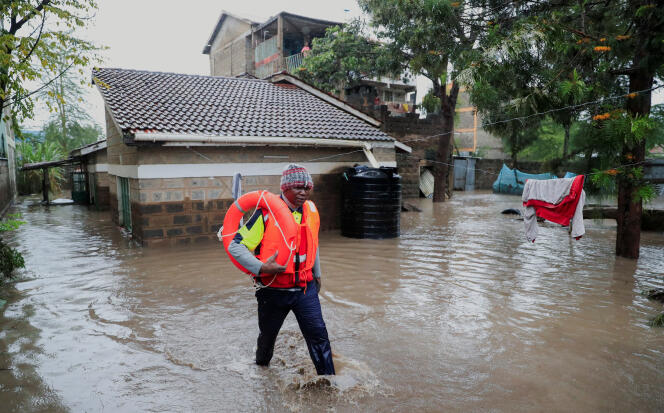Searches are carried out by scent, or by following the eyes of scavengers who fly over piles of trees and mud. In Kenya, about 100 people are still missing near the Mai Mahiu area in the Rift Valley, about 50 kilometers from Nairobi, where a landslide triggered by heavy rains claimed the lives of at least 50 people on Monday, April 29. In his thoughts, Edward Kenningi was searching the banks of the yellowish river. He surveyed the thick mud, where uprooted acacia trees, monkey corpses, and car wrecks were scattered together. Upriver, the reservoir that had built up over months around the abandoned railway tunnel collapsed under the pressure of heavy rain. The torrent washed away part of the mountain on Monday evening, then hundreds of homes downstream.
“We were submerged at 3 a.m. I managed to save my wife and children, but I lost everything else: 100 cattle and my house,” Kenenji said from the banks of the floods, where the army was deployed to recover. Bodies of missing people. Kenenji, who has been herding goats here for 15 years and had never witnessed anything like this before, confirmed that a flood of this magnitude was unprecedented in the area. Macarius Kamariu, a neighbour, was unable to warn his family in time as the water was falling down the slope. The father said: “The outbuilding in which the two teenagers lived was swept away before my eyes, and the next morning I found their bodies at a depth of 300 meters.”
One of Kenya's worst disasters ever
The heavy rains that have afflicted East Africa over the past month and a half have in some areas reached three times normal seasonal levels. While the Mai Mahiu landslide is one of Kenya's worst disasters, floods have claimed at least 188 lives and displaced 200,000 since the start of the rainy season in March.
After the first violent incident in November 2023, when rains had already killed 250 people and displaced a million people in East Africa, Kenya once again finds itself helpless in the face of these floods. The heavy rains are the result of two parallel phenomena: the El Niño climate phenomenon and the Indian Ocean Dipole, another climate anomaly – when the water surface temperature in the Indian Ocean is above normal to its west and below normal to its east.

“This is one of the most violent El Niño events since 1950,” said Rina Ghailani, UN Under-Secretary-General for El Niño Response. “Between 40 and 50 million people are affected in 16 countries.” The last major crisis in 1997 killed more than 6,000 people in East Africa.
You have 61.36% of this article left to read. The rest is for subscribers only.

. “Proud zombie lover. Evil pop culture buff. Amateur thinker. Total food practitioner. Tv evangelist.”
